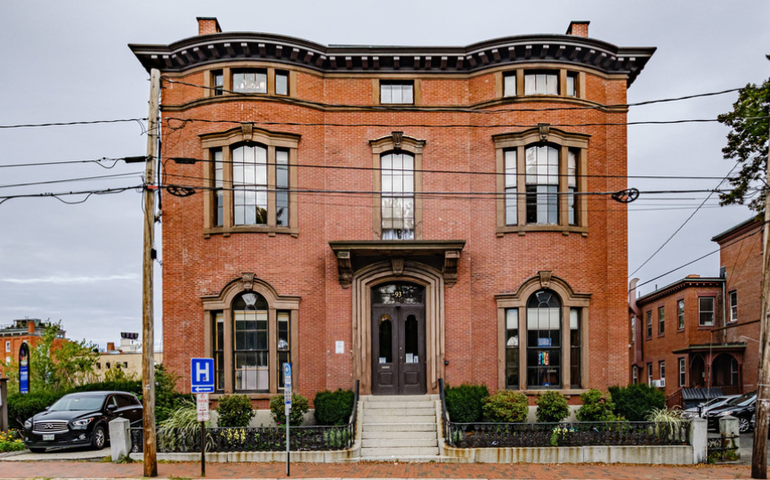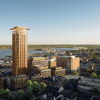
Greater Portland Landmarks sells historic headquarters to Portland design-build firm Woodhull
 COURTESY / GREATER PORTLAND LANDMARKS
Greater Portland Landmarks sold its headquarters, Safford House, to Portland architecture, construction and millwork firm Woodhull.
COURTESY / GREATER PORTLAND LANDMARKS
Greater Portland Landmarks sold its headquarters, Safford House, to Portland architecture, construction and millwork firm Woodhull.
Woodhull, a Portland architecture, construction and millwork firm, plans to move its headquarters this summer after purchasing a historic building at 93 High St. in Portland from Greater Portland Landmarks for $1.625 million.
Greater Portland Landmarks listed the three-story brick structure, built in 1858, with the Boulos Co. for $1.75 million.
Jessica Estes and Claire Richardson of the Boulos Co. represented the seller and Shannon Richards of Legacy Properties Sotheby’s International Realty represented the buyer in the transaction.
The 11,634-square-foot building, called Safford House, has served as the headquarters for GPL for 14 years. Founded in 1964, the nonprofit's mission is to preserve and revitalize greater Portland's historic buildings, neighborhoods, landscapes and parks.
“The building is in remarkably good shape,” said Woodhull’s founder and principal architect, Caleb Johnson. The property also includes onsite parking.
‘High style home’
According to the organization, Safford House is one of the last “high style homes” built on High Street in the 19th century. The building is attributed to Charles Alexander, one of Portland’s prominent 19th-century architects who helped popularized the Italianate style in the city
It was built for William Safford, a shipping merchant who traded with Cuba and was noted as the first merchant in Portland to store provisions on ice at his warehouse.
In 1938, Shaw Business College purchased the building and converted it from a residential dwelling. Succeeding owners included Unity Church of Truth and social service organization Volunteers of America. The building was also occupied by The Portland Society of Art - now Maine College of Art & Design - whose former staff and students recall using the rear lot as a sculpture garden.
In 1983, the Portland Society of Art sold the building with historic preservation covenants to Safford Associates, which completed a renovation of the building, adding a rear elevator and restoring some interior partitions removed by the Portland Society of Art to create large classrooms.
The seller
In 2004, Greater Portland Landmarks sold its longtime home at 165 State St. in Portland and began to search for a new location in a historic building in need of preservation. The following year, it purchased Safford House.
“Suffering from deferred maintenance, the building needed significant repairs to its building systems, roof and exterior facades,” the organization said.
Safford House became Greater Portland Landmarks’ headquarters in 2009. The organization developed a multi-phase preservation plan and implemented the most critical repairs in 2010 with the replacement of the roof and repairs to the cornice and frieze. Additional work included restoration of the original windows, masonry repairs, and interior improvements.
The rehabilitation and restoration work made the building work for modern office needs.
In November 2021, the trustees of Greater Portland Landmarks decided to put Safford House up for sale.
The organization recently moved to a temporary headquarters at 511 Congress St., Suite 502, in Portland.
“Still waiting for phones and internet to get set up, and it'll take us a little while to get fully situated, but we are so happy to be done with the first phase of the relocation,” said Sarah Hansen, Greater Portland Landmarks’ executive director. “Since the space is temporary, no rehab or fit-up is needed. It actually fits us perfectly — and the views from our offices are amazing.”
The nonprofit hopes to find permanent space by the end of the year.
“We have our eye on a spot, still in downtown Portland, and hope to settle into a more permanent situation by the end of the calendar year,” she said.
Hansen said this is a time of big change for the organization.
“While I can't let all the cats out of the bag quite yet, I can say that we've been doing a lot of work behind the scenes and have a truly incredible team of people who are fully invested in our mission,” she said. “We will be launching a new organizational brand soon and are thrilled to be able to reintroduce our group and our work.”
The buyer
Woodhull, formerly known as Caleb Johnson Studio|Woodhull of Maine, was founded in Biddeford in 2003 and moved to Portland in 2017.
Today, Woodhull consists of a partnership of eight professionals in various fields and employs about 75 architects, designers, cabinetmakers, support staff, construction project managers, project superintendents, estimators and carpenters.
The firm provides services throughout the life of a project and architecture; construction and millwork teams collaborate from the outset.
Its headquarters has been in leased space at 110 Exchange St. in Portland. It has a millwork shop in Brunswick and a carpentry shop and warehouse in Portland.
Jobs stretch from Westport Island, just south of Boothbay, to the southern border in Kittery.
Ever since moving to Portland, Johnson has been looking for a place to buy for the company’s headquarters.
“I was looking for a historic tax credit project on the peninsula with parking,” he said.
Johnson said he jumped on the opportunity to buy Safford House.

The company will consolidate its three locations to High Street, said Johnson.
“We’ll fill about 40 seats when we move in this summer,” he said. “And we’ll be able to expand to about 70 seats.”
Construction
The company plans two phases of construction.
The first phase involves the first and second floors, which are configured as four large bays of about 1,000 square feet each.
“Those rooms don’t need anything but new paint, flooring and lighting, and a little bit of demolition,” said Johnson. “They’re already quite beautiful.”
Phase 1 investment is expected to be about $470,000. It’s expected phase 1 will be complete by this August, at which time the staff will move in.
“We’ll tightly occupy 5,000 to 6,000 square feet,” he said. “Then we’ll proceed to renovate and restore the rest of the building around us for the 12 months following.”
Phase 2 will invest an additional $1 million or more for restoration projects that include repairing deteriorated exterior brownstone details and windows. The building has an ell on the rear that has to be ripped down to the studs and rebuilt, said Johnson.
The plan is to turn the full basement of about 3,000 square feet into a conference center, with a bathroom and a central gallery.
Other phase 2 projects include landscaping and adding electric vehicle charging stations; it’s expected phase 2 projects will be completed by summer 2024.
Financing
A bridge loan from Machias Savings Bank financed the purchase and the first phase of construction. Financing through the U.S. Small Business Administration 504 program, the federal Historic Preservation Tax Incentive program and the Maine State Rehabilitation Tax Credit program is expected to close this summer.
The 504 program provides loans advantageous to borrowers for certain commercial purposes in combination with a regular bank loan.
The federal Historic Preservation Tax Incentive program, administered by the IRS and the National Park Service, is designed to spur private investment in redeveloping historic buildings.
Johnson said he expects to close on the historic tax credit deals this summer. Maine Street Capital in Portland helped work out the financing.










0 Comments